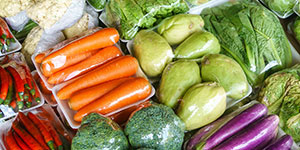Plastic packaging coming to a kitchen near you
The scraping of the plate — a sound so many of us recognize after a holiday feast or a large dinner. You know the routine, scrape the plate and the unsavory leftovers get dumped into the garbage. But, how often do we pause to consider the impact that food waste has on our environment
A recent survey conducted in the U.S. by Plastics Make it Possible® found that wasted food costs consumers anywhere from $640 to $900 a year, per household. Not only do the costs add up, the U.S. Environmental Protection Agency (EPA) attests that wasted food is the most prevalent material in our landfills and contributes significantly to greenhouse gas emissions.
Now visualize this
Data collected by the United Nation's Environment Program (UNEP) illustrates a stunning statistic: the amount of cropland used to produce the world's wasted food is equivalent to the size of Mexico!
Plastics play an essential role in lessening food waste and its environmental impacts. According to Plastics Make it Possible®, plastic helps provide barriers to oxygen, light, temperatures, moisture, microbes and other factors that lead to spoilage, so it can help us throw away less food.
Help protect the environment
To help protect the environment and your wallet, Plastics Make it Possible® provides simple tips for using plastics to help reduce wasted food at home:
- Wrap it up - Wrapping some fruits and vegetables in a little bit of plastic can help keep them fresher longer. For example, a plastic-wrapped cucumber can last three times longer than an unwrapped cucumber, and wrapping a banana in a lightweight plastic pouch can delay ripening by several days making it less likely that you'll end up having to throw away the produce you buy.
- Avoid waste - A wide variety of foods, such as dried fruit, nuts, cheese and much more, are available in lightweight, resealable plastic pouches. The built-in zipper allows you to squeeze out most air and save the extra food for later, so it's less likely to spoil. And the thin, lightweight plastic results in very little waste.
- Use only what you need - Search your supermarket shelves for individually packaged portions of side and main dishes - from lean meats to veggies - in lightweight plastic pouches that can be placed directly in the microwave and cooked in the package. Because these pouches are available in a variety of sizes, you can choose only the size and amount you need to help prevent wasted food and money.
- Keep it fresh - If you buy and store large quantities of ingredients to prepare wholesome meals throughout the week, you can use lidded plastic storage containers, zipper bags and wraps to help keep excess air away from these ingredients, which helps keep them fresh until they're ready to use.
- Protect leftovers - Plastic packaging can help keep our leftovers fresher longer so we throw away less food. And check the container label many plastic storage containers are labeled for both freezer and microwave use, so we can conveniently store, reheat and serve leftovers in the same container while easily controlling portion sizes.
- Extend your food budget - Plastics Make it Possible® advises that proper use of plastic zipper bags, storage containers and shrink wraps will help seal out air to prevent spoilage and freezer burn to extend the life of leftovers and fresh foods, reduce food waste and extend our food budget — while also helping protect the environment.
To learn how Chevron Phillips Chemical is supporting food waste efforts with its innovative Marlex® Polyethylene resins, click here.
Click on image or click here to view PDF (1.80 MB).
